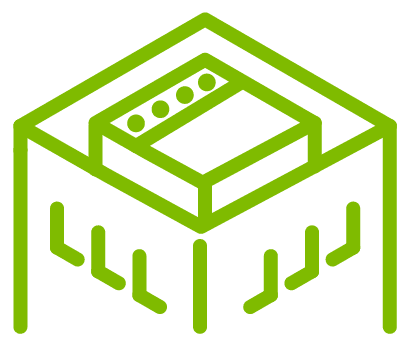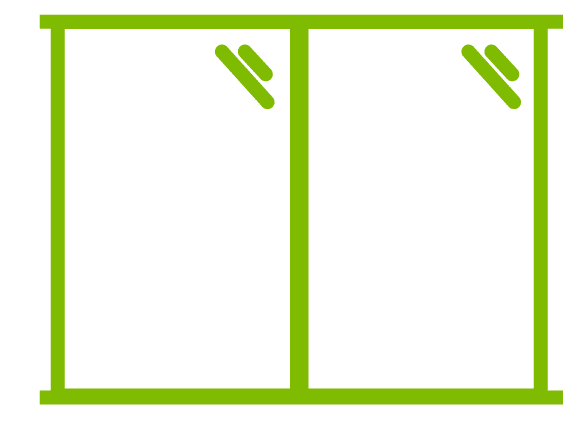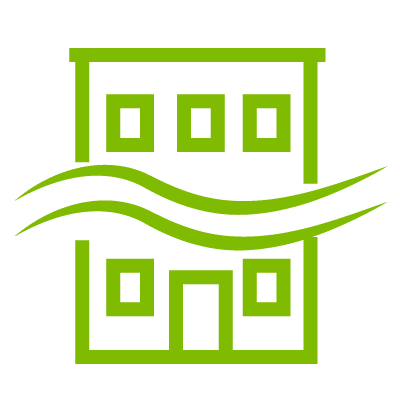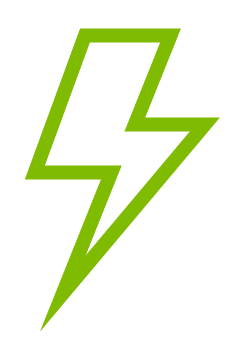To top it off, moisture doesn’t just come from rain. HVAC systems, condensation, plumbing leaks, and activities within the building can increase moisture levels that, if ignored, can lead to mold growth and other serious issues that compromise the safety and health of the people inside.
Fortunately, finding that moisture doesn’t require tearing up the whole roof. Commercial building roof moisture surveys are a nondestructive means of locating moisture trapped in a roof system, and Building Envelope Allies has years of experience surveying all kinds of commercial roofs.
Once identified, issues can be fixed as needed — without tearing up or replacing the entire roof. Read on to learn the steps of two main types of roof moisture surveys we perform: infrared scans and nuclear surveys.
Infrared roof moisture survey
Infrared roof moisture scans find water leaks and/or trapped moisture by identifying soaked insulation inside roofing systems. Wet insulation isn’t as efficient as dry insulation, so it creates a temperature difference that’s visible with infrared imaging technology.
This type of roof moisture scanning can be an affordable, nondestructive solution for flat or low-slope roofs. However, it requires precise weather conditions for accurate results, and it may not be the only testing necessary for a complete roof system moisture evaluation.
Here are the steps of a commercial building infrared roof scan:
1. Scan the roof
Using the latest infrared equipment, our certified thermographers carefully scan the entire surface of your roof. We look for areas that are a different temperature than the rest of the roof, highlighted by red, orange, or yellow thermographic readings.
2. Mark ‘wet’ areas
Highlighted areas may indicate water leaks or saturated insulation, because water-soaked roofing materials retain more heat than dry materials (after solar loading). We mark these areas on the roof so you can find them later.
3. Review results
Following the infrared roof scan, we create a report with our findings. The report includes detailed information about any trapped moisture we identified, so you can verify damage and develop a repair plan.
Nuclear roof moisture survey
Nuclear roof moisture surveys are very accurate, and this type of scan can detect layers of moisture in most roofing systems, including ballasted roofs. Our inspectors perform nuclear roof surveys in a wide range of weather conditions.
Nuclear gauges detect water using small amounts of radiation, which penetrates deep into the roof system without the need for destructive testing. Nuclear Scans can detect moisture deeper within a roofing system compared to an infrared scan which can only detect moisture in the upper part of the system.
Here’s what to expect with a commercial building nuclear roof moisture survey:
1. Measure a grid over the roof
Our technicians start by measuring a grid pattern across the entire roof surface. Most nuclear roof moisture survey grids are 10’ x 10’, but sometimes we use 5’ x 5’ grids depending on the building.
2. Note characteristics of the roof
Once the grid is marked, we may record all the structures and equipment both on the roof and penetrating it, as well as any areas that have obviously been repaired. Making note of these features allows us to accurately account for them in the survey results.
3. Take nuclear readings
Then, we take nuclear readings at each grid intersection across the roof. The nuclear gauge uses tiny amounts of radiation to detect hydrogen particles in the roof, indicating water is present.
If we detect elevated moisture levels, we take additional readings. We record all readings in data sheets to create your final report.
4. Review results
After completing the roof survey, we review the results and compile our findings. Building Envelope Allies’ nuclear roof moisture survey reports include detailed CAD drawings, which clearly show you the location and extent of any elevated moisture readings.
Roof moisture surveys should be part of every commercial building’s preventive maintenance schedule. Surveys identify water leaks and trapped moisture, so you can fix the damage before bigger issues develop inside your building.
At Building Envelope Allies, our Level II and Level III certified infrared thermographers and technicians perform best-in-industry nondestructive roof surveys. Request a roof moisture survey quote from Building Envelope Allies to get started.







